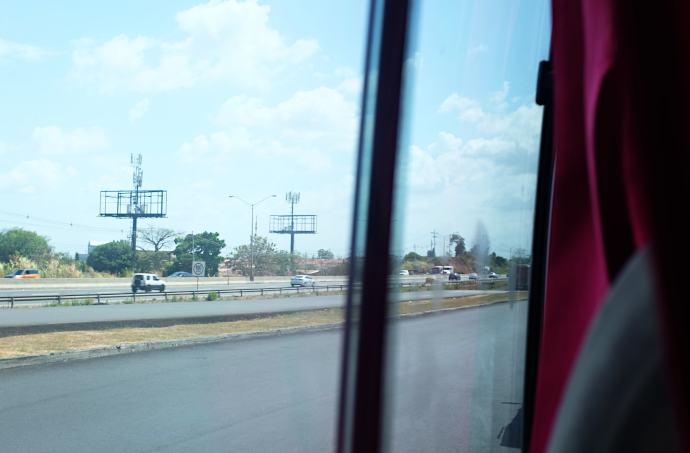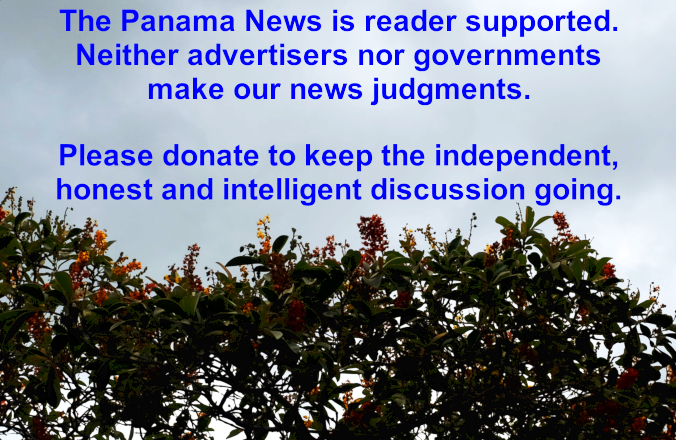Looking out the bus window, changing conditions in the Panamanian economy emerge from the things you see and the repeated patterns in them. Photo by Eric Jackson.
Not exactly in the form of a “he said, she said” story
by Eric Jackson
In a sense, it’s like 2019, when the government changed hands and a lot of people were asking about who would eat the losses from unsold inventory of all sorts throughout the national economy. Outgoing gangs had taken their pickings and usually were wary of being too obvious. The prudent sticky fingers were also wary about investing in new ventures when no longer riding the gravy train. Plenty of folks in the previous gangs were flat-out on the run, and having bought out a big share of the nation’s billboards, Ricardo Martinelli was finding that lots of businesses were wary of any connection that might be perceived if they rented advertising space from him. But the biggest underlying bottom line was that less business was being done. It was a real estate buyer’s market. Construction projects languished unfinished, or were done but no occupants were to be found.
The Panamanian economy limped along, and then the COVID epidemic hit. Many of the upscale resident foreigners took evacuation flights, never to return. Some left with plans to come back from their also infected and chaotic countries of origin, sometimes to shocking scenes of what had happened to their property in their absence when they did return. The vaunted “expat community” is substantially reduced and that’s a Panamanian business reality.
During and just after the lockdown, while riding by on the busses it was easy enough to see all of the businesses that had been smashed into and looted. Then came brave new businesses, mostly informal ventures by the side of the road, but also renovations, expansions and replacements of more substantial companies that had suffered so much during the lockdown.
(How much of the devastation at COVID’s worst points was directly due to the deaths or illnesses of owners or key employees? That would be an interesting mashup of economic and medical history to research and write.)
Most small businesses that start up do not succeed for very long. So there was another wave of economic change to be seen from the buses, roadside stands that had been opened or reopened, then abandoned. Little drive-up businesses with no customers parked out front. Buildings that had visibly been smashed into during the lockdown and ensuing crime wave, now fixed up but not yet open for business.
Now the order of who is doing which business where is altered, even among companies with deep pockets. For those with the money to risk investing during hard times, there are some assets to acquire or build cheaply. Other than mergers and acquisitions – especially in the telecommunications business — the tales of roving cannibals are exaggerated.
So there are the self-serving declarations of Panama’s business tycoons and wannabes, and the often snobbish declarations of international financial institutions and bond rating services, and of course all o the political propaganda that takes credit or assigns blame, in each case often unduly so.
And again, there are observations from riding down the highway. All the empty billboards are a dead giveaway of an ailing economy. It might even be an apt time, imparting less pain to fewer companies and people, to just ban that sort of advertising.
And of the companies that are putting up billboards, the winding curves of Campana Hill and straightaways from below that into the beaches community also tell of a huge “before” and “after” market change. Gone are the pictures of blonde families in their upscale beachfront homes, with the messages written in English. That’s not the market anymore, if it ever was. Matchbox tracts with Spanish-language ‘you could be home by now’ pitches are the offerings you see now.
Which may feed into the politics of ‘It doesn’t faze Panama or its business climate if all the rest of the upscale foreigners are driven out, either.’
And so at the US Consulate you see relatively few US citizens waiting to be served, and this crowds of Panamanians lined up to get visas to the United States. You don’t see THAT from a bus, but you may see it at the midpoint main order of business punctuating a day mostly spent on buses between the Interior and Panama City.
Contact us by email at fund4thepanamanews@gmail.com
To fend off hackers, organized trolls and other online vandalism, our website comments feature is switched off. Instead, come to our Facebook page to join in the discussion.
These links are interactive — click on the boxes












